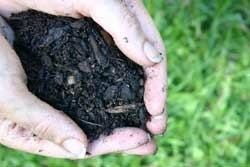 Many vegetables, like tomatoes, beans, squash and peppers need soil temperatures to reach nearly 70ºF before their growth can really take off. By solarizing your soil a month before you set out your warm-weather vegetables, you can fast forward your garden calendar and speed up your harvest by as much as two weeks!
Many vegetables, like tomatoes, beans, squash and peppers need soil temperatures to reach nearly 70ºF before their growth can really take off. By solarizing your soil a month before you set out your warm-weather vegetables, you can fast forward your garden calendar and speed up your harvest by as much as two weeks!
To prepare your soil for solarization, start by gently turning over the soil in the area you will be planting. Do this about a month before you normally set out your warm-weather vegetables. You don't need to dig deep, just down far enough to remove any surface weeds and leftover plant debris from last fall.
When planting, try to keep your holes and furrows fairly shallow so you disturb the soil as little as possible. Only the weeds and weed seeds in the upper layer of soil have been solarized, so you want to avoid bringing any new seeds to the surface.
If you decide to leave the plastic on, make sure you protect your plants from the sun by covering the entire area (including the plastic) with 3-4 inches of mulch after planting. If you don't, the plastic will continue to heat up and overheat, or worse, kill off your young plants. You'll also need to create slits in the plastic for watering. The plastic will help keep moisture in, but it also prevents moisture from evaporating so be careful not to overwater.
Clear Plastic: It allows solar radiation in, but doesn't let it back out. For simple heating, a clear plastic is the best.
White and Red Plastic: These two colors don't heat the soil as well as clear plastic, but they reflect light back onto plant leaves, which encourages new growth. Tomatoes are said to be especially fond of red plastic, while potatoes are said to prefer white.
Black Plastic: Black (or other dark colors) is the best choice if you want to heat your soil and kill weeds at the same time. Black will prevent any light from reaching the soil. When combined with heat, black is the most lethal combination for weeds.
By preheating your soil, you'll be able to harvest some of your warm weather crops up to two weeks earlier than usual. Combine solarization with early producing varieties and get ready for your earliest harvest ever!
Sounds like a little too much work for me.
I did this once for some tomatoes and left the plastic down, cutting slits for the plants to go in. I had no weeds, but terrible fungus and mold all season.